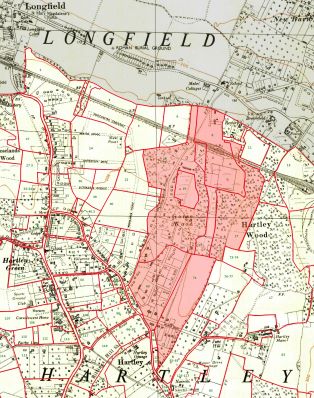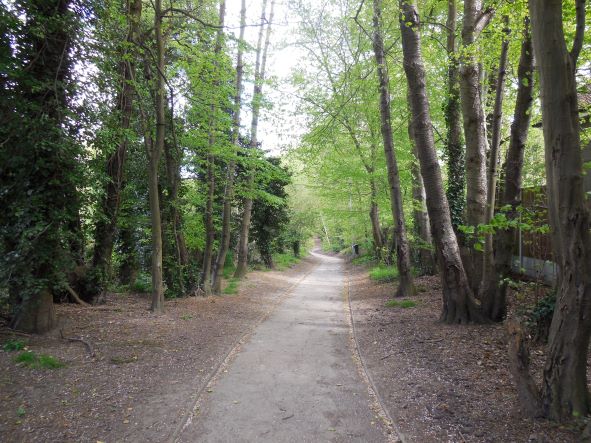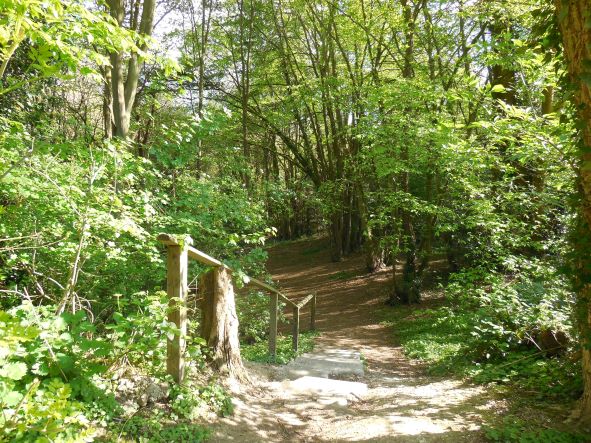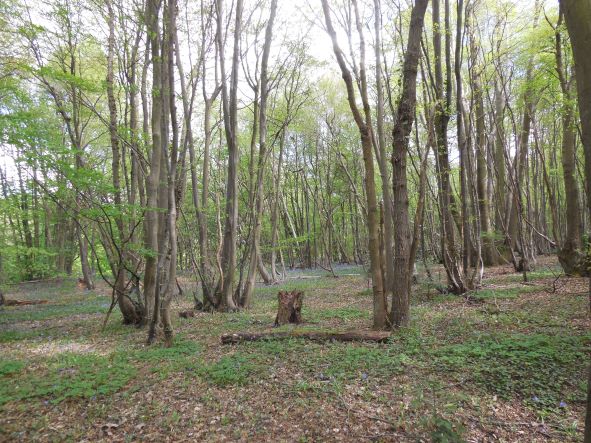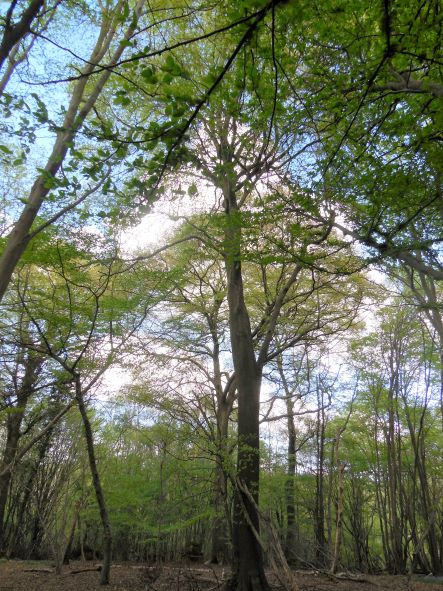Gorse Wood and Hartley Wood
It is difficult to know the extent of medieval woodland at Hartley. The -leah place name in Hartley is used of land won from the trees, but early records record very low acreage of woodland. A clue may be in the 1421 inquisition mentioned below, which hints that they are mainly interested in woods with a commercial value.
Hartley Wood from Longfield end of Hartley Bottom Road (March 2019)
Looking south from Longfield, much of the view of Hartley is still woodland as surely it must have been since Anglo-Saxon times. Most of what can be seen is the 75 acres (30 ha) or so of Hartley Wood. A 3½ acre (1.5 ha) fragment of Gorse Wood is nestled between the Wellfield Estate and Gorsewood Road. However the western part of what we call Hartley Wood today was historically part of Gorse Wood.
It appears that the two woods were originally scrub land on the edge of a large open field called Northfield. When John Urban died in 1421 the woodland belonging to the manor was only reckoned to 10 acres and that is more likely to be Foxborough Wood. The inquisition post mortem said there was 80 acres of pasture and “in the said manor are diverse heath and little woods, which are worth nothing annually except as enclosures of the manor aforesaid”. This would be for temporary field enclosures.
Part of the land was sold in 1541 by the lord of the manor, Nicholas Ballard to Thomas Swan of Southfleet. It was described as 120 acres of land and 11 acres of wood. Four years later Thomas seems to have given it to his son-in-law Robert Gens of Southfleet and his wife Dorothy, as part of a marriage settlement. It appears Hartley Court still owned the eastern part of Hartley Wood, and this was definitely a wood in 1633 (when it was described as so in a conveyance of neighbouring land). The map below shows the approximate location of Northfield. This is based on modern place name evidence (in 1844 field numbers 69 and 71 were called Northfield) and from a `1633 conveyance of neighbouring Hartley Manor Farm (its bounds are given by reference to neighbouring landowners).
Approximate Location of Northfield
Robert died in 1575 and his inquisition post mortem says he owned Northfield which was one field of 80 acres which was a mixture of farmland and scrub (“furze and heath”). He also owned Stocks Farm and Middle Farm. Northfield was only valued at 7½d per acre per year while the two farms were valued at 1s 6d per acre, suggesting a lack of intensive use.
We next hear of them in 1610 on the inquisition taken after the death of Michael Beresford of Westerham. Now the single field had been parcelled out and Gorse Wood is mentioned for the first time by name as “Hartley Gosse”: "…and of and in divers parcels of land called Northefeld or Great Northefeld and Hartley Gosse, containing by estimation 108 acres of land, lying in Hartley in the said county of Kent”.
It seems the Beresfords were interested in commercial wood management and it appears they expanded the extent of woodland. Their tenant of Goldsmiths Cottage in Hartley Bottom Road was Richard Stephens, “colyer” or charcoal maker, a woodland profession. In Kent charcoal was greatly used for iron smelting, but Hartley would have been too far away from the Wealden Iron sites for transport to be economic. Charcoal was also used by blacksmiths, and by 1590 Hartley had lime kilns to make quicklime for agriculture.
When Michael’s grandson Michael died in 1628 the 100 acres were all described as being “woodground”. His brother and heir Thomas Beresford sold Northfield to Edward Churchill, possibly of Aylesford in 1635. Then it was described as 60 acres of arable land, 10 acres of pasture, 10 acres of scrub and 60 acres of wood, clearly a big change from 50 years previously. At some point after this land was reacquired by the lords of Hartley Manor. At the time of tithe survey of 1844, Gorse Wood (34 acres), Hartley Wood (63 acres) together with a 5 acre arable field taken from the woods called Grub Piece belonged to Mr Bensted as owner of Hartley Court.
By the 19th century we get more plentiful evidence of the commercial use of the woodland through sale notices in the local papers. Sometimes an area of coppiced woodland was sold (e.g. 12 acres at Hartley Wood in 1854. 10 acres at Hartley Wood in 1863. 34 acres of 11-14 year old trees at Hartley and “Goss” Woods in 1871. 90 mature oak timber trees at Hartley Wood in 1880). At other times wood products were for sale (e.g. 18,000 hop poles varying between 10-16 feet long in 1860. And wood for fuel and bavins for broom making in 1880).
The other main reason gentlemen of the day kept woodland was for pheasant shooting, and Hartley Wood was no exception. Falling timber prices after 1866 meant use for game became far more important. The surviving rhododendron trees in Hartley Wood are probably evidence of this as Victorian landowners planted shrubs to create cover for the birds. When the Hartley Court Estate was sold in 1901 the brochure says “…it forms a capital sporting property, the woods and plantations being extensive and well stocked with English, Chinese and Japanese Pheasants, and abounding with wild flowers and wild birds. They are admirably placed for rearing a large head of game.” The same brochure said Hartley Wood was then 54 acres and Gorse Wood 34 acres in size. The decline in the size of Hartley Wood since 1844 was down to part being sold to Newington Vestry for the Longfield Refuse Dump.
When Small Owners Limited bought the Hartley Court estate, they sold off the two woods in 3 parcels.
(1) The part of Gorse Wood west of Gorsewood Road and the centre of Hartley Wood (37 on the Small Owners sales map – see link) was sold in 1919 to car manufacturers Adam Grimaldi & Co Limited for £1,728. All of this was sold for housing, but not all developed. The land at Strawberry Valley was split up into building plots in the 1940s but planning permission was not granted. The deed plan below shows the road that was planned to be built. The ownership of many of these plots is not known.

Deed plan for sale of plot in Hartley Wood 1943
The 20th century saw a continual decline in the size of Gorse Wood as more land was lost to development, first of Gorsewood Road, and then the Wellfield Estate till only about 3 acres are left. Charles (1927-2011) and Patricia Hart (1932-2015) of Gorsewood Road campaigned with some success to save what remained in 1976. He said “plant a tree in 73” had in Hartley become “grind them to sticks in 76!” Sevenoaks transferred Gorse Wood to Hartley Parish Council in 1978 with a covenant that it must be public amenity land. It does suffer to some extent for being urban amenity land, for there has been persistent fly tipping problems.
Gorse Wood with Caxton Close in background
(2) The part of Gorse Wood east of Gorsewood Road and the western part of Hartley Wood (36 on map) was sold in 1915 to May Bishop and Hedley Symons, much of which is Gorsewood Farm today. Charles Ellerby says during World War 1 he worked for Hedley Symons cutting down trees in Hartley Wood for pit props, which is the last known commercial forestry use.
(3) The remaining eastern portion of Hartley Wood (143 on map, roughly east of the footpath from Hartley Manor to the Railway) was sold to the London Borough of Southwark. They still own the land but since 2009 this has become a village green which allows general access. There was a lengthy public enquiry held in the Church Hall which determined this, where the inspector found the parish council had established sufficient grounds, although she criticised their conduct in some regards, for example using a proforma witness statement rather than getting people to use their own words and who they chose not to give evidence. She also felt some of the parish council's witnesses had exaggerated their use of the wood. Southwark on the other hand, who objected to the application, suffered from very poor record keeping.
Today the woods’ main use is for local amenity, a pleasant walk on a warm summer’s day. William Bradford (Hart Nov 85, Jan 86) remembered walking through the woods in the 1920s and 1930s, where “jays, wood pigeons, [nightingales], and green woodpeckers for their delightful ‘yaffle’ or laughing cry, seemingly so full of optimism, and the joys of life…”. He also remembered the many wild strawberry plants along the path leading into the woods from the bottom of Gorsewood Road, which gave it the name Strawberry Valley.
Hartley Wood: Gorsewood Road Entrance
Hartley Wood: Beechlands Close Entrance
Hartley Wood: Coppicing
Hartley Wood: Beech Standard

